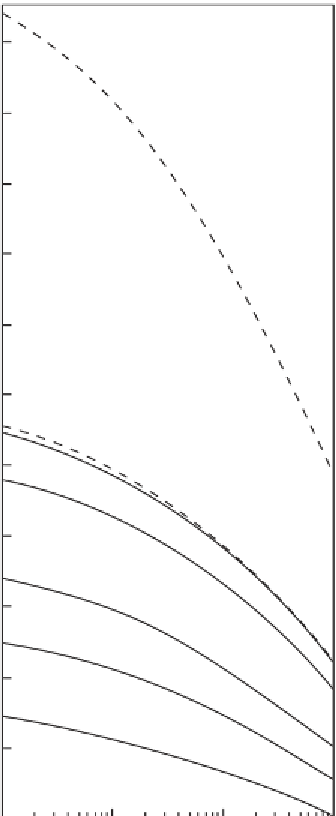Geoscience Reference
In-Depth Information
detect flash flood events in small catchments. Finally,
and more importantly, if the rainfall regime becomes
wetter, then rare events of say 1:100 years may
suddenly become common events of 1:20 years or less.
For example, in eastern Australia, rainfall between
1948 and 1993 increased by 30 per cent over the
previous thirty years. The period witnessed exceptional
localized and regional rainfalls that could not possibly
be accounted for using standard and accepted proba-
bility of exceedence diagrams. Some of these events
will be described later in this chapter.
An alternative approach uses the concept of
maximum probable rainfall
that can fall in a catchment
within a set period, given optimum conditions. The
procedure was developed in the United States in
the 1940s. Extreme rainfalls are generated by large,
virtually stationary thunderstorms; or by mesoscale
synoptic storm systems containing convective cells.
The amount of precipitation that can fall over a set
time in a given area is a function of the available
moisture in a column of air, and the efficiency of any
storm system in causing condensation and aggregation
of water particles. Because intense cells have a limited
size, the amount of rainfall falling over a catchment
becomes a function of the catchment size. Small catch-
ments approximating the area of a thunderstorm will
receive more rainfall than large catchments in which
a thunderstorm occupies only part of the area. The
rate of condensation, while dependent upon climatic
relationships, is also dependent upon topography.
Rough terrain, in which elevation changes by 50 m
or more within 400 m - especially in close proximity
to the ocean - can trigger thunderstorms or trap
convective cells for several hours. Many locations in
the Wollongong area of Australia and along the
Balcones Escarpment in Texas favor maximum
probable rainfall because of rough topography.
Figure 6.6 presents the maximum probable rainfalls
that theoretically can fall within fixed periods for
smooth or rough topography. For example, a small
urban catchment of about 10 km
2
consisting of smooth
topography can have maximum probable rainfalls of
about 460 mm within an hour (point A in Figure 6.6).
If it rains for three hours, this value can rise to 660 mm
(point B). However, if the catchment is rough then the
maximum probable rainfall for the three-hour period
can amount to 840 mm - a 27 per cent increase (Point
C). Because tropical air holds more moisture per
volume than air at the poles, the values derived from
1200
R = rough topography
S = smooth topography
1000
C
X
800
X
B
600
A
X
400
200
1
10
100
1000
Drainage Basin Area (km
2
)
Maximum probable rainfalls per unit time by drainage basin
area (Australian Bureau of Meteorology, 1984).
Fig. 6.6
Figure 6.6 must be corrected for latitude. Typically this
correction is 0.65 at mid-latitude locations such as
Sydney, Australia or Los Angeles, California. This
latitudinal correction reduces the values mentioned
above to approximately 300 mm, 430 mm, and
550 mm, respectively, at these two latter locations.
Figure 6.6 illustrates several factors about flash
flooding. First, beware of small catchments. That
babbling brook meandering intermittently through
one's backyard can turn into a raging torrent under
innocuous conditions. In Wollongong, Australia, flash
flooding with the attendant movement of boulders has
occurred in small creeks within 100 m of a similar-sized




































